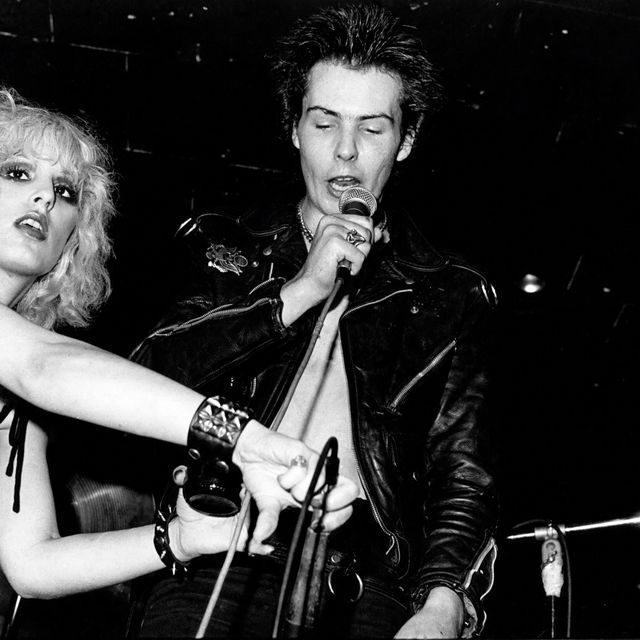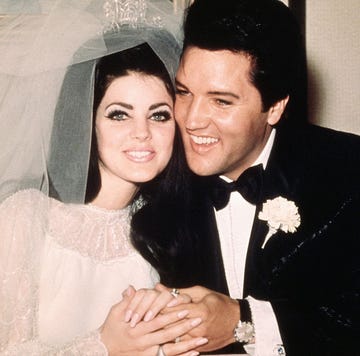He was born in England and endured a peripatetic childhood with a single, drug-abusing mother, before finding acceptance amid the other spiky-haired teens who flocked to London's King's Road in the early 1970s.
She was born in a comfortable Philadelphia suburb but proved too volatile for conformity, landing in a mental institution and then a school for troubled kids before running off to New York City at age 17.
Ultimately, Sid Vicious and Nancy Spungen found their common ground in the combustible arena of punk rock until driving over the edge together, like a musical Bonnie and Clyde, joined in death as they were over the final months of their lives.
It was love at first sight for Vicious and Spungen
By the mid-1970s, Vicious was a fixture in London's punk circles both as a musician (he was a drummer for Siouxsie and the Banshees and Flowers of Romance) and as a symbol of the explicit anti-establishment movement (he reportedly invented its popular "pogo" dance).
In February 1977, the bad boy got his big chance when nominated to replace Glen Matlock as bassist of the Sex Pistols, then known for their 1976 hit "Anarchy in the U.K.," even though he didn't know a thing about playing the bass.
Shortly afterward, Spungen arrived in London. A groupie from the New York punk scene, she was generally regarded as loud, obnoxious and unlikeable, spurned by the other groupies and accepted by the musicians largely for her ability to procure heroin. She soon made a move on Sex Pistols frontman Johnny Rotten and, finding an unreceptive audience, turned her attention to Vicious.
It was love at first, discordant sight.
In Vicious she found a naturally shy soul, one enduring of her hard edges, as well as the irresistible pull of a star on the rise. And in Spungen, he found someone experienced and nurturing in grown-up matters of sex and drugs, while also proving needy for his own brand of affection.
One onlooker later captured the unique nature of their bond, describing how Spungen once instructed Vicious to push a fawning groupie down the stairs at a club. "And he did, without a second thought," recalled the witness. "He was a knight in rusty armor."
Their behavior deteriorated through excessive drug use
As the Pistols improbably thrashed their way into the mainstream, riding the turbulent wave of singles like May 1977's "God Save the Queen," Vicious and Spungen became inseparable. According to Sid's Way: The Life and Death of Sid Vicious, the couple moved into a flat in the quiet west London neighborhood of Maida Vale, where they sunk further into heavy drug use and fended off intrusions from the police.
Meanwhile, the rest of the Pistols, not exactly a harmonious unit to begin with, chafed at the enduring presence of the abrasive American. Manager Malcolm McLaren later admitted to trying to have her "kidnapped" and put on a plane back to New York, though the couple's inability to be apart rendered that plan impossible.
The group managed to have Spungen banned from their U.S. tour in January 1978, and Vicious responded by behaving erratically, at one point smashing an audience member over the head with his bass in Dallas.
The Pistols would not survive the tour – they disbanded after a disastrous appearance at San Francisco's Winterland Ballroom on January 14 – and Vicious showed how poorly he functioned when left to his own devices, going on a bender that led to a methadone overdose and his hospitalization in Queens, New York.
Reunited with Spungen following his discharge, the lovebirds journeyed to Paris to film the Pistols mockumentary The Great Rock n' Roll Swindle. The enterprise again dissolved into mayhem, with Vicious preferring to shoot up in his hotel room instead of joining the production. When he did leave the room, recalled director Julian Temple, Spungen made sure to remind him of the error of his ways.
"I remember coming back one day," said Temple, "And she'd cut her wrists, there was blood all over the bed and she'd faked up a suicide attempt to really make Sid feel that he shouldn't leave her, even for a few hours, to do any filming."
Spungen was found stabbed to death in their hotel room
In August 1978, the couple moved to New York City and set up in room No. 100 of Manhattan's Chelsea Hotel. By this point, Spungen was acting as Vicious' manager. Along with getting him gigs in her old Lower East Side haunts, she served as Vicious' spokesperson when he was too stoned to communicate in the occasional media appearance.
Their high-wire lifestyle came to an inevitable crash on the night of October 11. Hosting a party in their tiny room, Vicious swallowed about 30 tablets of Tuinal – a potent barbiturate mix – and was comatose for most of the night as guests came and went.
At around 11 a.m. the following morning, as the front desk began receiving calls of distress about the situation in room 100, a bellman discovered an underwear-clad Spungen on the floor, bleeding profusely from a knife wound to her abdomen. A dazed Vicious was found wandering in the hallway, reportedly wailing about how he killed her. He repeated that admission to the police before recanting, insisting that he didn't remember anything about the night.
Vicious died less than four months after Spungen from a heroin overdose
Freed on bail, Vicious was powerless to withstand the overwhelming loss in his life and attempted suicide a few days later. After spending two months in the Riker's Island prison complex, he celebrated his release in February 1979 by sending his mother to score some heroin. On the morning of February 2, the punk icon was discovered dead from an overdose.
Over the ensuing decades, old friends have sought to put together the pieces to determine, as much as possible, just what happened to Spungen. Some have emphasized Vicious' drug-induced stupor as evidence of his innocence, pointing to the shady characters who filtered through room 100 that night as the more likely suspects. Others have suggested that her death was part of a botched double-suicide attempt.
Whatever the cause, the survivors of that era are in agreement about the tragic couple's feelings for one another: "She was his first and only love of his life," McLaren wrote. "As everyone knows, you may argue with your first ... [want to] leave them, move on, and be with others — but you never get over them."












